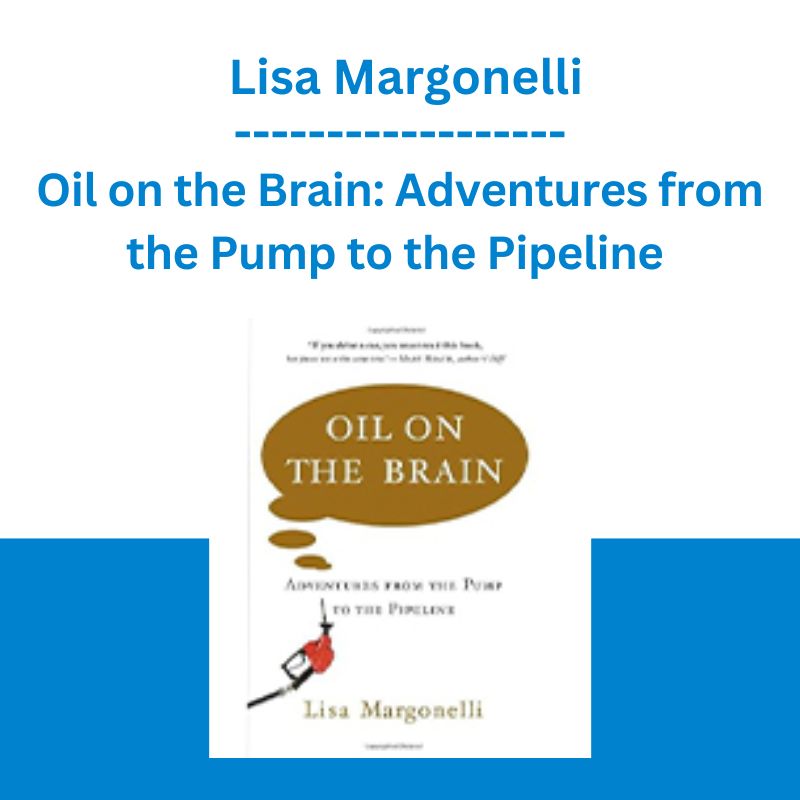*** Proof of Product ***
Exploring the Essential Features of “Oil on the Brain: Adventures from the Pump to the Pipeline – Lisa Margonelli”
Oil on the Brain: Adventures from the Pump to the Pipeline Hardcover
by Lisa Margonelli (Author)
Oil on the Brain is a smart, surprisingly funny account of the oil industry—the people, economies, and pipelines that bring us petroleum, brilliantly illuminating a world we encounter every day.
Americans buy ten thousand gallons of gasoline a second, without giving it much of a thought. Where does all this gas come from? Lisa Margonelli’s desire to learn took her on a one-hundred thousand mile journey from her local gas station to oil fields half a world away. In search of the truth behind the myths, she wriggled her way into some of the most off-limits places on earth: the Strategic Petroleum Reserve, the New York Mercantile Exchange’s crude oil market, oil fields from Venezuela, to Texas, to Chad, and even an Iranian oil platform where the United States fought a forgotten one-day battle.
In a story by turns surreal and alarming, Margonelli meets lonely workers on a Texas drilling rig, an oil analyst who almost gave birth on the NYMEX trading floor, Chadian villagers who are said to wander the oil fields in the guise of lions, a Nigerian warlord who changed the world price of oil with a single cell phone call, and Shanghai bureaucrats who dream of creating a new Detroit.
Deftly piecing together the mammoth economy of oil, Margonelli finds a series of stark warning signs for American drivers.
Editorial Reviews
From Publishers Weekly
Starred Review. In the last few years, just about everyone has had “oil on the brain” at some point, as record gas prices and a disastrous war have called our dependency into question. But though the U.S. burns 10,000 gallons of gasoline a second, few of us know how oil is created and drilled, how gas stations compete or what actually goes on in a refinery—let alone what happens in the mysterious Strategic Petroleum Reserve, where the U.S. government stores roughly 700 million barrels of oil in underground salt caverns on the Gulf Coast of Texas. Margonelli answers these questions and more, before examining some of the key patches in the oil industry’s geopolitical quilt: source countries like Chad, where promises of real local growth fall hopelessly short, or China, which, “by 2025, perhaps, will import as much crude oil as the U.S. does now.” Writing in a witty, first-person voice, Margonelli criticizes corruption in places like Nigeria, while expressing her “love of hydrocarbons” for the unlikeliness of their formation and the ingenuity required to extricate them. This is an original, open-minded look at a subject about which everyone has an opinion. (Feb. 6)
From Booklist
Margonelli has written about the culture and economy of energy for publications such as Wired, Discover, Salon, and the San Francisco Chronicle. In the summer of 2003, she started hanging out at independent gas stations, where owners might clear pennies per gallon of gas, surviving on impulse sales of junk food and soda. Her journey takes us up the delivery chain, spending a typical day with a tanker truck driver, hanging out with suppliers, touring refineries, and seeing what life is like at an oil rig. Whether visiting “wildcatters” in Texas, the Strategic Petroleum Reserve in the Gulf of Mexico, or the oil pit at the New York Mercantile Exchange, Margonelli charms her way into the good graces of insiders to report on the vast petroleum network. Her voyage takes us to Venezuela, Chad, Nigeria, and ultimately the Persian Gulf, where she spends time at the Salmon oil fields in Iran. Filled with rich history, industry anecdotes, and politics, Margonelli’s book brings a deeper appreciation of the complicated and often tenuous process that we take for granted. David Siegfried
Review
“Oil on the Brain is hugely enjoyable, compulsively readable, and brilliantly reported. I feared reading a book on oil would be akin to being told ‘eat your carrots.’ But from page one, Lisa Margonelli made oil into brain candy, and kept it so till the end.”
–Po Bronson
“Lisa Margonelli has a rare and precious talent. She has drawn a wonderfully readable portrait of the fascinating and surprisingly little-known human face of Big Oil.”
–Simon Winchester
“Oil on the Brain could be called “The Petro-economy for Dummies”–and especially hardcore dummies like me who insist on being entertained as well as educated. From the corner gas station to the oil fields of Nigeria, there couldn’t be a better traveling companion than Margonelli. She’s fast, fearless, funny, and a brilliant observer.”
–Barbara Ehrenreich
“Very few people are smart enough to tackle a subject as complicated as world oil, and of those people, I would wager that not one of them could do it with the humor and crackle and delight that Margonelli brings to bear. If you drive a car, you must read this book, but please not at the same time.”
—Mary Roach, author of Spook and Stiff
“Margonelli’s approach is quirky but comprehensive, informal but rigorous: Margonelli has a facility with numbers and an easy way with policy, and the narrative passages here, lightly first-person and often funny, help make accessible the facts of our dependence on oil….Daniel Yergin’s magisterial book The Prize remains unsurpassed as a modern history of oil. But Oil on the Brain, kaleidoscopic, accessible and focused on our present quandry, is a timely sequel.”
–Ted Conover, The New York Times Book Review
“Oil on the Brain is an original, open-minded look at a subject about which everyone has an opinion.”
–Publishers Weekly (starred review)
“Filled with rich history, industry anecdotes, and politics, Margonelli’s book brings a deeper appreciation of the complicated and often tenuous process that we take for granted every time we fill up our tank.”
–Booklist
“[Margonelli’s] approach is quirky but comprehensive, informal but rigorous. . . . [K]aleidoscopic, accessible, and focused on our present quandary.”
–New York Times
“[I]lluminating, entertaining…”
–San Francisco Chronicle
“Margonelli invites us to leapfrog the rhetoric, dry statistics, and dire pronouncements about oil in order to truly understand it.”
–Fast Company
“An especially welcome addition to literature . . . [Margonelli] gives us witty tales about her misadventures as well as loads of gossipy details.”
–Ms. magazine
“Whether you agree with [Margonelli’s] conclusions or not, they will make you think twice next time you fill your tank.”
–St. Petersburg Times
“A fascinating drive.”
–Atlanta Journal Constitution
“The structure of Margonelli’s narrative is unexpected, even daring, as she works backward along the demand-supply chain.”
–St. Louis Post-Dispatch
“Margonelli does a masterful job of humanizing [oil’s] passage from underground to pump handle.”
–Houston Chronicle
About the Author
LISA MARGONELLI is currently an Irvine Fellow at the New America Foundation. She has written for the San Francisco Chronicle, Wired, Business 2.0, Discover, and Jane, and was the recipient of a Sundance Institute Fellowship and an excellence in journalism award from the Northern California Society of Professional Journalists. She is based in Oakland, California.
Excerpt. © Reprinted by permission. All rights reserved.
1
GAS STATION: Chasing The Hidden Penny
Regular Unleaded $1.61 9/10
Twin Peaks Petroleum sits at a welcoming angle to a busy San Francisco intersection. On this morning in the summer of 2003, a thick fog has crawled over the station, folding each of the eight drivers standing at the pumps in an envelope of cold mist. At the back of the lot sits a garage where a small convenience store glows. On the storefront is a poster of an ebullient snowman clutching a cola, while icicle letters drip the words COLD POP over his head. Inside the convenience store, among the security cameras and parabolic mirrors, the Doritos, cigarettes, and Snapples, jammed into a space no larger than a postal truck, a tall man with dark circles under his eyes appears to doze. His eyelids hang low, twitching; he mumbles; he moves with excruciating deliberation as he counts change.
I am leaning against a shelf holding several grades of motor oil, individually wrapped strawberry cheesecake muffins, and four flavors of corn nuts: picante, regular, nacho cheese, and ranch. I am no more lively than B. J., the droopy manager. And I am recording the flavors of corn nuts in my notebook to stay awake. “Corn Gone Wrong” say the packages. I record that too. I’ve come to the gas station to watch Americans buy gasoline, as a way of understanding how we fit into the trillion–dollar world oil economy. But now that I’m here, I realize I’ve been here before, bought gas so many times myself I feel there’s nothing to see. The fumble, the stuporous swipe of the card, the far–off look: I know them well. Gas stations are everywhere, but when you’re in one, you’re nowhere in particular. Icicle letters are taking shape in my head: WHAT DID YOU EXPECT?
I keep writing: Trojan spermicidally lubricated snugger fit, two Sominex and a folded paper cup, phone cards, batteries, air fresheners printed to look like ice cream sundaes, a greeting card with a picture of a pansy and the words “You’re too nice to be sick.” The customers standing out at the pumps have a preoccupied, anxious look—could they be distracted enough to buy a card that says “You’re too nice to be sick”?
Gas stations are collections of incidental items, impulses, and routines that seem in themselves to be inconsequential but aggregate into a goliath economy when multiplied by the hungers of 194 million licensed American drivers. Corn nuts, for example, are part of $4.4 billion in salty snacks sold at gas station convenience stores yearly, nearly all impulse buys. The hopeful purchase $25 billion in lottery tickets. People with the sniffles spent $323 million on cold medicine at gas stations in 2001. And the faint smell of gasoline near the pumps? In California alone, the amount of gasoline vapor wafting out of stations, as we fill our cars, totals 15,811 gallons a day—roughly the equivalent of two full tanker trucks (1). In the gas station, we’ve collaborated to create a culture of speed, convenience, low prices, and 64–ounce cup holders, which allow us to express what the industry calls our “passion for fountain drinks.” Japanese auto executives have hired American anthropologists to explain the mystery of why the purchase of a $40,000 car hangs on the super–sizing of the cup holder.
And then there is the gasoline: 1,143 gallons per household per year, purchased in two–and–a–half–minute dashes. We make 16 billion stops at gas stations yearly, taking final delivery on 140 billion gallons of gasoline that has traveled around the world in tanker ships, pipelines, and shiny silver trucks. And then we peel out, get on with our real lives, get back on the highway, or go find a restroom that’s open, for Pete’s sake.
With a wave of our powerful credit cards, American drivers buy one-ninth of the world’s crude oil production per day. That makes us elephants in the global oil economy–our needs are felt around the world, from the tiniest villages in Africa, the Amazon, and the Arctic, to the highest towers in Vienna, Riyadh, and New York. When we lick our lips, they open their taps. When we are in a funk, their governments fall. Here in front of the pump, surrounded by buntings in the joyful colors of children’s birthday party balloons, we have the opportunity to be our truest selves in the great, over–the–top drama/business that is the world oil supply chain.
But as you know, buying gas can be done by the living dead. Swipe card, insert nozzle, punch the button with the greasy sheen: Gasoline flows into the tank while money flows out of the bank account. Filling a car seems less like making a purchase than a ritual, a formality that isn’t quite real.
It’s not even clear what we’re buying—gasoline’s fantastic uniformity means one is as good as another. Water doesn’t mix with gas, so beyond occasional traces of vapor, we don’t even have to worry about buying substandard gasoline. And all traces of where the fuel came from are completely erased by the time it gets to a gas pump. Texaco gasoline is no longer from Texas, and gas from Unocal is not from “Cal.” Both companies have been purchased by Chevron, anyway. If gasoline were coffee, we might believe the Baku blend offered a fast but mellow ride.
As if acknowledging the futility of trying to stand out from the pack when 168,987 gas stations are selling essentially an identical chemical mix, stations have adopted a clannish ugliness. Whether they’re in Fairbanks, Alaska, or Pine Island, Florida, they all subscribe to the familiar topography of canopied islands, cheerful plate glass, struggling hedges, and “Smile. You’re being watched by a surveillance camera” signs. Predictable they are, to the very last 9/10ths of a cent, which is permanently printed on every last gas price sign in the land.
The gas station’s blandness is misleading, though. Hidden in its windows, pumps, and hedges are clues to the true nature of the American bargain with gasoline and the enigma of its role in the world.
On the counter in front of B. J. stands a line of purple plastic wizards, stomachs filled with green candy pebbles. Their shiny eyes stare at me expectantly.
At the periphery of my vision, a van enters Twin Peaks yard and parks near the fence. In the time it takes the door to slam, B. J. grows a foot taller, loses his paunch, and becomes a man of action. He snaps the countertop open, bounces into the yard, and lands in front of the van driver in one tigerlike swoop. Words are exchanged. The driver sulkily returns to his van and B. J. returns to the store, shaking his head. People try to ditch their cars in the station and take the bus, he explains, taking his position behind the wizards. “The customer is always right,” says B. J., “but bad people going round.”
Like vapors, bad people always seem to be wafting through the gas station. Last week B. J. ran out to stop a truck that was barreling toward the station’s lighted canopy. The truck driver ignored him and crunched the canopy. Cars have driven willy nilly through the hedges as he watched. Nightly, people break through the chains on the four entrances. Once he found a gun in the hedge, stashed by a kid on the way to juvenile court. His response? Shave the hedges. Every morning he cleans up garbage, cans, and bottles filled with things we won’t discuss. Daily, and constantly, people try to steal: window squeegees, sodas, condoms, money, and phone calls. Behind B. J.’s head are the counterfeit $20 bills the station has intercepted.
People use elaborate schemes to steal gas, he explains. Sometimes they’ll pay for $5 and shut the pump off when it reaches $4.75. Then they return to the clerk, telling him to turn the pump back on, knowing that the pumps don’t turn off after dispensing amounts less than a dollar. Then they fill their tank and drive off. Others play on the sympathies of the attendant or accuse him of trying to cheat them. In stations where people pump before they pay, they often just drive off. The average gas station loses more than $2,141 a year to gasoline theft. Some lose much more.
Think of a gas station as a crime scene before the fact, and you’ll start to appreciate it as a maze engineered for belligerent rats. Hedges, which I’d interpreted as a pathetic attempt at dignity and baronial pretensions, actually eliminate escape routes for would–be robbers, limiting holdups. Many convenience stores buy “target hardening” kits, which include decals imprinted with rulers so that clerks can tell the police how tall the robbers were, two stickers that say “No 20s, no 50s,” two “Thank You” decals, and one “Smile. You are being watched by our video security.”
Even so, crime is always evolving. “After we did target hardening in stores in the 1980s, the crime moved to the pumps—carjackings and abductions,” says Dr. Rosemary Erickson, a sociologist who’s studied gas station crime for thirty years. “Now it’s public nuisance crimes in the parking lots. Gas stations are considered a magnet.” (2) Nearly nine percent of U.S. robberies happen in gas stations and convenience stores, and the average gas station lost $1,749 to robbery in 2004.
Some of the crimes are not about money at all; they’re about freefloating anger. When gas prices are high, more people get “pump rage” and try to drive off without paying for gas. The Indian and Pakistani immigrants who own and staff many stations bear the brunt. After 9/11, people who were angry at some vague combination of OPEC and Osama bin Laden attacked a hundred clerks at 7–Eleven gas stations and convenience stores in a month. Five men were killed for looking “Middle Ea…
Product details
Publisher : Nan A. Talese; First Edition
Language : English
Hardcover : 336 pages
Customer reviews
Frederick S. Goethel
Everything You Need To Know About Oil…But Didn’t Know How To Ask
“Oil on the Brain: Adventures from the Pump to the Pipeline” is the story, from beginning to end, of how oil is pumped, traded, refined, distributed and sold to the public. In addition, the book covers the conditions, both political and cultural, in a number of oil producing countries.
The book is divided roughly in half. The first half follows the flow of fuel from its start in the ground through the various handlers until it is pumped into your car. The author, however, doesn’t just recite a litany of facts. She narrates well and adds information about the processes that are not common knowledge. The second half of the book is a look at where oil originates and the conditions in those countries as they relate to oil. And, the reality is that there is a socio-economic result of discovering and pumping oil from the earth.
The author does a wonderful job of weaving a story out of a number of rather dull facts and makes the book interesting, as well as informative. Her writing style reminded me of the books by Eric Schlosser or Barbara Ehrenreich.
After reading the book I found myself looking at gas stations in a new light and thinking about what I was doing every time I pulled up to the pump. I also noticed I was taking a few extra steps to try to cut my consumption a little. I think this book has a powerful message that needs to be read by the oil consuming public which may help to change their purchasing habits.
PETER G
Entertaining and informative
I found this book engaging and informative, written in an entertaining style. Good read and quite a few surprising facts I would not have imagined.
Please see the full list of alternative group-buy courses available here: https://lunacourse.com/shop/










 SMB - Options Training
SMB - Options Training  Simpler Trading - Bruce Marshall - The Options Defense Course
Simpler Trading - Bruce Marshall - The Options Defense Course